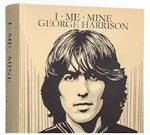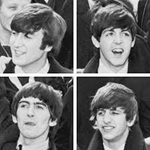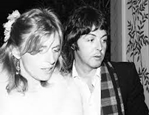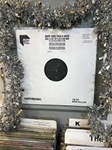- Register
- Log in to Tune-In
- Wishlist (0)
-
Shopping cart
(0)
You have no items in your shopping cart.
Beatles News

Old people have wisdom — and now, behind-the-scenes knowledge about the making of The Beatles’ 1970 album “Let It Be.”
According to Nielsen, the Thanksgiving Week 2021 debut of Peter Jackson’s Disney+ docuseries “The Beatles: Get Back” was viewed by people primarily (54%) over the age of 55. Those golden oldies racked up an impressive 503 million minutes streamed between three episodes over their first four days. (“The Beatles: Get Back” premiered Episode 1 on Thanksgiving Night, Nov. 25. Episode 2 on the following evening and the third and final episode on Saturday, Nov. 27. The Nielsen week also included Sunday, Nov. 28.)
Those 500-million-plus minutes streamed placed “Get Back” seventh among original streaming programs that week. It did not make the Top 10 overall when counting acquired programs.
Source: Tony Maglio/yahoo.com
details
The very last song The Beatles recorded before they broke up was ‘I Me Mine’ but it wasn’t all of The Beatles.
As many people learned watching Peter Jackson’s ‘Get Back’, the album that became ‘Let It Be’ was recorded before ‘Abbey Road’ but released after ‘Abbey Road’.
The ‘Let It Be’ album was delayed a: because the planned ‘Get Back’ album was scrapped (it is now part of the new ‘Let It Be’ box set) and b: The ‘Let It Be’ album was awaiting the release of the ‘Let It Be’ movie (the original footage that Jackson used to create the ‘Get Back’ series.
The Beatles finished the ‘Get Back’ sessions in January 1969. In February 1969 they started work on the ‘Abbey Road’ album. ‘Abbey Road’ was released on 26 September 1969 and the ‘Let It Be’ album was released on 8 May 1970.
Source: Paul Cashmere/noise11.com
details
George Harrison and Jimi Hendrix never officially met, but they had similar views on fame. They were two of the most famous musicians in the 1960s, George with The Beatles and Hendrix with The Jimi Hendrix Experience. However, neither of them could be bothered with fame. All they cared about was their music.
George Harrison in denim in 1967 and Jimi Hendrix in velvet in 1966.
During an interview on The Dick Cavett Show, Hendrix revealed what he thought of fame. Cavett asked him what kind of compliments he liked to hear. Hendrix said he didn’t like compliments.
“I don’t know, I don’t really live on compliments,” Hendrix said. “Matter of fact, it has a way of distracting me. A whole lot of other musicians and artists out there today, you know they hear these compliments, they say, ‘Wow, I must have been really great.’
Source: cheatsheet.com
details
Just when everyone thought there wasn’t any stone left unturned when it came to documenting every aspect of the most influential and arguably greatest rock band of all time, director Peter Jackson (“The Lord of The Rings,” “The Hobbit”) gifted the world with “The Beatles: Get Back” this past Thanksgiving. Jackson’s three-part documentary is composed of 60 hours of footage and 120 hours of audio that were not used in a previous Beatles documentary, “Let It Be” (1970), directed by Michael Lindsay-Hogg. The premise of the film was to show The Beatles in their studio candidly writing, composing and recording what would be their final two albums (“Abbey Road” and “Let it Be”) at the start of the new year in January 1969. The film’s climax featured the band performing live on the roof of Apple Studio for what would be their last performance.
Source: The Commentator
details
The Beatles may have broken up in 1970 and two of them have since died but, in effect, they’re still together and business is brisk.
A glance at the credits for “The Beatles: Get Back,” the Peter Jackson docuseries that chronicles the making of the album “Let it Be,” shows the names atop the list to be Paul McCartney, Ringo Starr, Yoko Ono and Olivia Harrison.
The nearly eight-hour documentary, which makes one wonder whether the Fab Four can still pull it off, is an initiative by the Beatles to show a less ornery view of one of the band’s last acts. It’s a rosier picture than what was shown 50 years ago in the original film made about these sessions. “Get Back,” with its share of playfulness and bickering (including a scene where George Harrison briefly quits the band), is a journey through the lads’ creative process alongside their frolic and fractures.
Source: thestar.com
details
"For the first time, John and Paul knew that George had risen to their level" – Beatles engineer Geoff Emerick track-by-track interview on Abbey Road
It is an image as memorable as the moon landing - and one copied by tourists on a daily basis. (Even a few bands have paid homage, most notably Booker T & The MGs.)
Ironically, that picture was a last-minute decision. During the recording of what was to be their swan song, The Beatles toyed with several titles, and Everest, a reference to the brand of cigarettes their late chief engineer, Geoff Emerick, smoked, was the favourite.
So Ringo said, 'Why don't we just shoot the cover outside and call it Abbey Road?' Like many a Ringo suggestion, it won out.
Source: Joe Bosso/musicradar.com
details
When the official trailer for The Beatles: Get Back was released in October, commentary across social media often referenced how harmonious and collegial the band looked in the footage. Undoubtedly, much of the anticipation surrounding Peter Jackson's docu-series was its suggestion that the Beatles' final years were much less acrimonious than previously believed.
In tandem with this, another set of comments focused on Yoko Ono’s inclusion in the jovial preview. After all, the 1970 Beatles documentary Let It Be, directed by Michael Lindsay-Hogg – which was created from the same 60-plus hours of footage – has not only served as supposed evidence of the group’s disintegration, but as “proof” that artist Ono, John Lennon’s then girlfriend and soon-to-be wife, played a major role in the world’s greatest rock band splintering apart.
Source: Christine Feldman-Barrett/news24.com
details
Mary McCartney has shared her fondest memories of mother Linda with her father, Paul McCartney, in a new interview.
Speaking to The Times, Mary and Paul reflected on family Christmases and how Linda helped raise awareness of vegetarianism.
Mary argued that many of Paul’s fans disliked Linda because she “didn’t fit the mould of the woman they wanted” him to marry.
“Being a vegetarian family in the late 1970s marked you out as different,” she said. “Everybody said it was all Mum’s idea and she’d forced Dad to stop eating meat, but they did it as a team. I remember them discussing recipes and Dad saying he still wanted something he could slice for his Sunday roast. Mum was always excited about cooking and she inspired me.
“Dad’s pretty good in the kitchen — he’d make a great sous-chef,” she added. “If you ask him to sort out the mashed potato, it’ll be the best you’ve ever tasted. He’s meticulous, just like he is in the studio.”
Source: independent.co.uk

PAUL MCCARTNEY has spoken out about how he and John Lennon wrote a song about their friend after their death, but the song was later banned from radio.
In 1967 John Lennon and Paul McCartney worked together to write a new batch of songs for The Beatles' eighth studio album Sgt Pepper's Lonely Hearts Club Band. During their writing sessions, the pair heard some tragic news about one of their friends, prompting them to write candidly about losing one of their pals.In McCartney's new book, The Lyrics: 1956 to the Present, he delved into the secrets of how he and Lennon wrote A Day In The Life. The song was a joint effort between the two pals mourning the loss of their friend, Tara Browne.
Source: Callum Crumlish/express.co.uk
details
In life, I think, there are only three ways that we can relate to the Beatles, which is fewer than you could say for any other band. (Yes, okay, there are probably people—probably millions of people, on this planet—who simply don’t know them, but this is Paste and you know what I mean.)
The overwhelming majority of us fall into the three basic camps. First, the obsessed devotees, of which there are many. Second, the iconoclasts who delight in blowing our minds with radical takes like, “actually, the Beatles suck.” And third, my group: the “casuals” who appreciate the music but aren’t diehards. That’s most of us, I think, but the sheer status of the Beatles means that even casuals aren’t truly casual… which is why even for people like me, it’s such a thrill to watch the most famous band in human history interact in the Get Back docuseries.
Source: By Paste Staff/pastemagazine.com
details
Peter Jackson's Get Back is a musical documentary unlike any other. Rather than featuring interviews with those involved, Get Back is styled with a more "fly on the wall" approach. The cameras are simply pointed at The Beatles and capture their every move, whether it's arguing amongst each other, goofing around, smoking cigarettes, or making music.
The latter is perhaps the most interesting thing about the entire documentary. The magic of Get Back is in watching some of the most iconic pop songs of all time take shape. Many songs can be seen getting crafted, and it makes for fascinating viewing.
Source: Nathan Sharp/screenrant.com
details
Keith Richards and George Harrison knew a thing or two about being a lead guitarist in a world-famous rock band.
As The Rolling Stones’ lead guitarist, Richards was the mastermind behind famous guitar riffs in songs like “Brown Sugar” and “Honky Tonk Women.” Meanwhile, George always knew how to fill out Beatles’ songs like “Day Tripper” and “If I Needed Someone.”
Knowing what it took to make each other their bands dominate the charts bonded them in a way. Without them, there wouldn’t be The Beatles or The Rolling Stones.
In the special edition of Rolling Stone, “Remembering George,” published months after George died in 2001, Richards spoke about his relationship with his guitar-playing counterpart. He said that he thought he and George had a “bond.”
“George and I kind of formed-without talking too much about it, although we did have a laugh here and there-a bond, in that we felt we were kind of fulfilling the same role within our respective bands,” Richards said. “It was a nod and a wink to say, ‘Well, they’d be nowhere without us.’
Source: cheatsheet.com

‘The Beatles: Get Back': How Peter Jackson Found 60 Hours of Unseen Fab Four Footage
The ”Lord of the Rings“ director spun a meeting with The Beatles’ business managers into a documentary pitch
“The Beatles: Get Back” director Peter Jackson’s gargantuan feat of compiling 60 hours of never-before-seen footage of the Fab Four’s “Let It Be” recording sessions — as well as new interviews with Paul McCartney and others who were at the scene 52 years ago — actually began as a different project altogether.
Source: Harper Lambert/thewrap.com
details
A record shop in Newcastle is just one of fifty charities or businesses across the country to receive an early Christmas gift courtesy of musical Royalty.
Yoko Ono and Sean Ono Lennon - the wife and son, respectively, of John Lennon - sent out the extremely rare copies of the song Happy Xmas (War Is Over) to 'spread Xmas cheer.'
Through a letter, recipients are advised to do whatever they choose with the vinyl, be it "sell, auction, raise money to help your business or your favourite charity."
The record is an acetate, hand-cut at the famous Abbey Road studios to mark the 50th anniversary of the single's first release.
Source: ITV News
details
Fifty years ago, the breakup of the Beatles divided American music fans. Recently, the debate over why the best-selling group broke up has been revived by Peter Jackson's new documentary series The Beatles: Get Back, which documents the making of the band's final album, Let it Be.
While half of Americans say they lack an opinion on the issue, those who hold one are most likely to attribute the British rock band's dissolution to Yoko Ono, the wife and collaborator of the group’s founder, John Lennon.
Speculation regarding Ono’s role in the band’s split is not new. This narrative has been called into question in recent weeks, however, following an interview in which band member Paul McCartney attributed the band’s breakup to Lennon, rather than Ono. Lennon is the culprit for one in four Americans with an opinion on the breakup. Far fewer attribute the Beatles’ breakup to other members of the band, including Paul McCartney (5%), George Harrison (3%), and Ringo Starr (2%). About 10% say someone else is responsible for the dissolution.
Source: Taylor Orth/today.yougov.com
